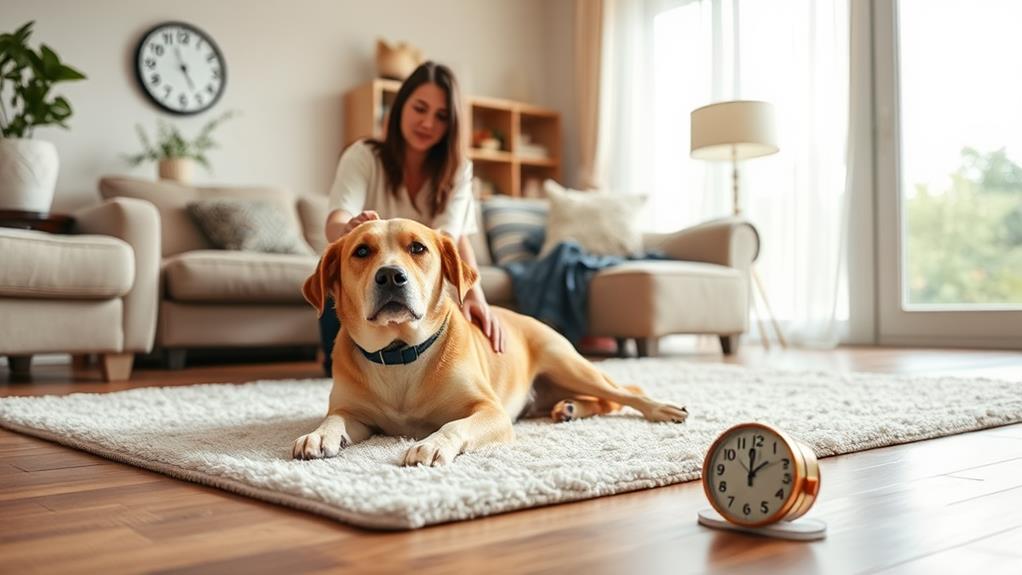Dog training can notably help address separation anxiety by building your dog's confidence and easing their distress when you're not home. You'll learn to use positive reinforcement to reward calm behavior and establish routines that provide predictability. Gradual desensitization techniques let your dog adjust to being alone through short departures. Interactive toys keep them engaged, while creating a safe space can make them feel secure. Additionally, professional training options can tailor strategies to your dog's needs. By working together, you'll strengthen your bond and help your canine companion thrive, making them more comfortable during your absences. There's much more to explore!
Understanding Separation Anxiety
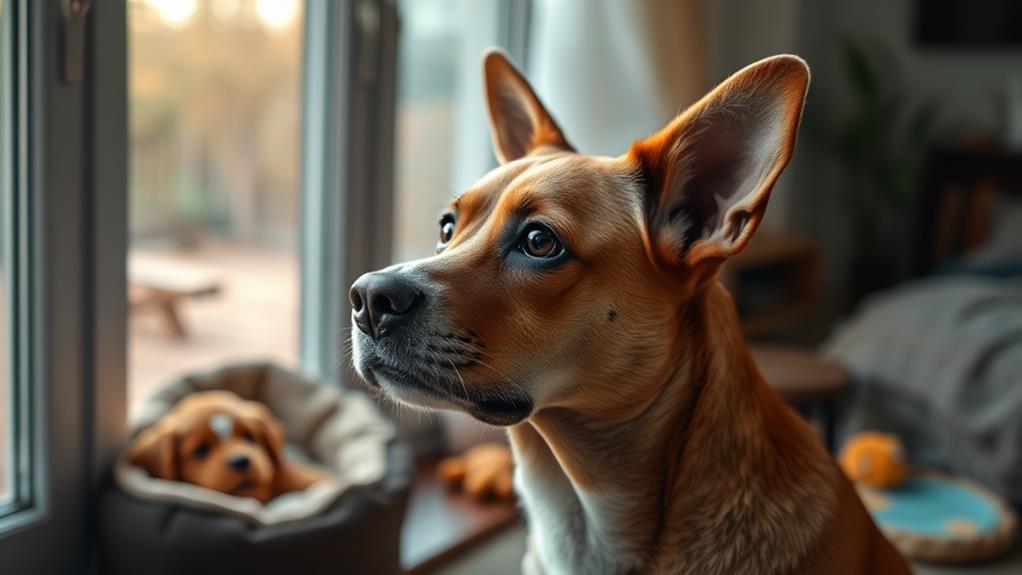
When your dog experiences separation anxiety, it can be both heartbreaking and frustrating. This condition occurs when your furry friend feels intense distress when you leave them alone. Understanding the root causes is indispensable for effective training.
Dogs are social animals, and they thrive on companionship. If they've had a traumatic experience, such as being abandoned or losing a previous owner, they may develop a fear of being left alone.
Additionally, some breeds are more prone to separation anxiety than others, often due to their strong attachment to their families. You might notice your dog becoming overly reliant on your presence, following you everywhere or showing signs of distress at even the slightest hint of you leaving.
Recognizing these behaviors can help you take proactive steps in addressing the issue. It's important to remember that separation anxiety isn't just misbehavior; it's a genuine emotional response. Patience is vital when you're working through this with your pup. Understanding the emotional landscape of your dog's mind will guide you in creating a more supportive environment, making the journey toward overcoming separation anxiety smoother for both of you.
Signs of Separation Anxiety
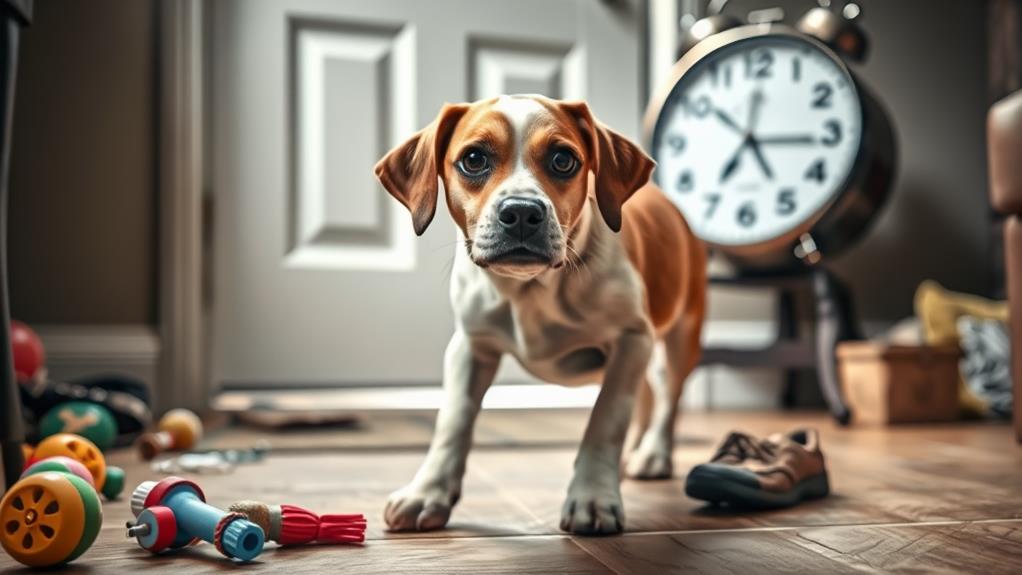
Identifying the signs of separation anxiety in your dog can make a significant difference in addressing the issue early on. It's important to watch for behaviors that indicate your pup is struggling when left alone. These signs can vary, but recognizing them is vital for effective training.
| Sign | Description |
|---|---|
| Excessive Barking | Your dog barks or howls continuously when you leave. |
| Destructive Behavior | Chewing furniture or digging at doors when alone. |
| Pacing or Restlessness | Your dog can't settle down and keeps moving around. |
| Potty Accidents | Urinating or defecating indoors despite being trained. |
| Clinginess | Following you everywhere and showing distress at your departure. |
Common Causes of Anxiety
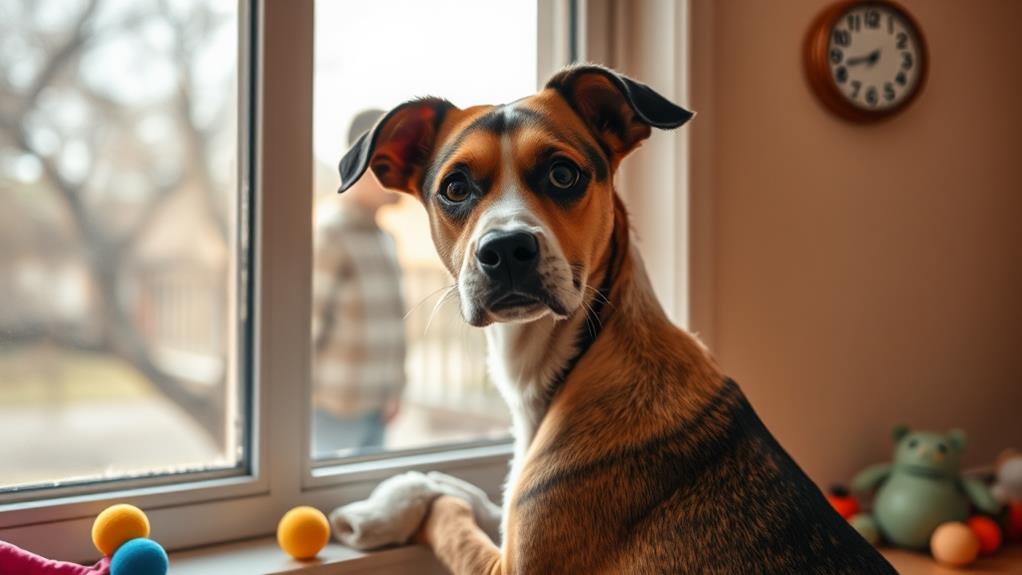
Separation anxiety in dogs often stems from various factors that can disrupt their sense of security. Understanding these causes can help you address the issue effectively. Here are three common triggers:
- Change in Routine: Dogs thrive on consistency. A sudden change in your schedule, like a new job or shift in daily activities, can leave them feeling insecure and anxious.
- Loss or Abandonment: Dogs form strong bonds with their owners. If they've experienced the loss of a companion—whether it's another pet or a human—they may react by becoming clingy or anxious when left alone.
- Lack of Socialization: If your dog hasn't been properly socialized, they may struggle with loneliness or unfamiliar environments. Limited exposure to new experiences can make them more vulnerable to anxiety when you leave.
Recognizing these causes is the first step in helping your dog feel more secure. By addressing these underlying issues, you can start to alleviate their anxiety and foster a feeling of safety when you're not around.
Importance of Positive Reinforcement
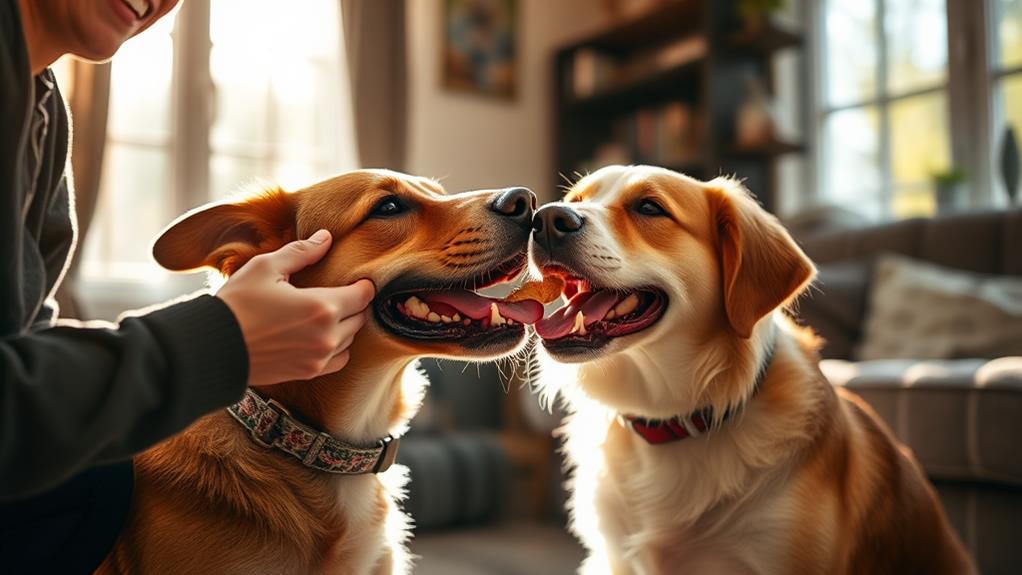
Harnessing the power of positive reinforcement can be a game-changer in training dogs with separation anxiety. When you use rewards like treats, praise, or playtime, you help your dog associate your departures with positive experiences. This approach builds their confidence and reduces fear. Instead of focusing on what your dog does wrong, you'll highlight the behaviors you want to encourage.
Start by rewarding your dog for calm behavior when you prepare to leave. This could mean giving them a treat as you grab your keys or putting them in their favorite spot. By reinforcing these positive actions, you create a more relaxed environment around your comings and goings.
It's essential to be consistent. Whenever your dog remains calm during your departures, reward them immediately. This consistency helps your dog understand that staying calm leads to positive outcomes.
Gradual Desensitization Techniques
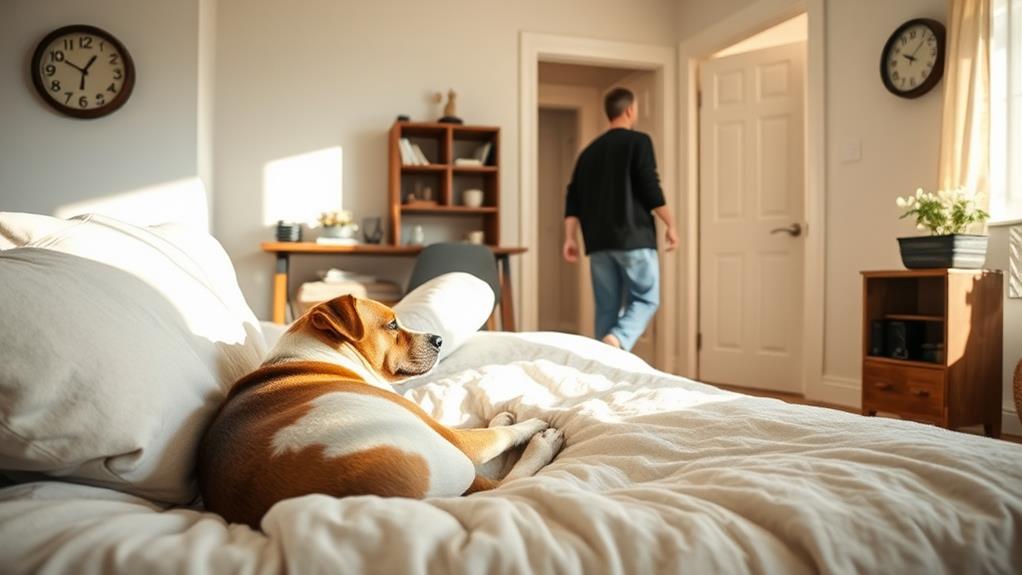
Building on the foundation of positive reinforcement, gradual desensitization techniques can further help your dog overcome separation anxiety. This method involves slowly getting your dog used to being alone in a controlled manner. By taking small steps, you can help your furry friend build confidence and reduce anxiety.
Here's how you can implement gradual desensitization:
- Short Departures: Start by leaving your dog alone for just a few minutes. Gradually increase the time you're away as your dog becomes more comfortable with each departure.
- Practice Leaving: Create a routine where you mimic the actions of leaving—grab your keys, put on your shoes, and walk to the door without actually leaving. This helps your dog associate these actions with calmness rather than anxiety.
- Reward Calm Behavior: When you return, reward your dog for being calm and relaxed. Use treats or praise to reinforce that being alone is a positive experience.
Creating a Safe Space
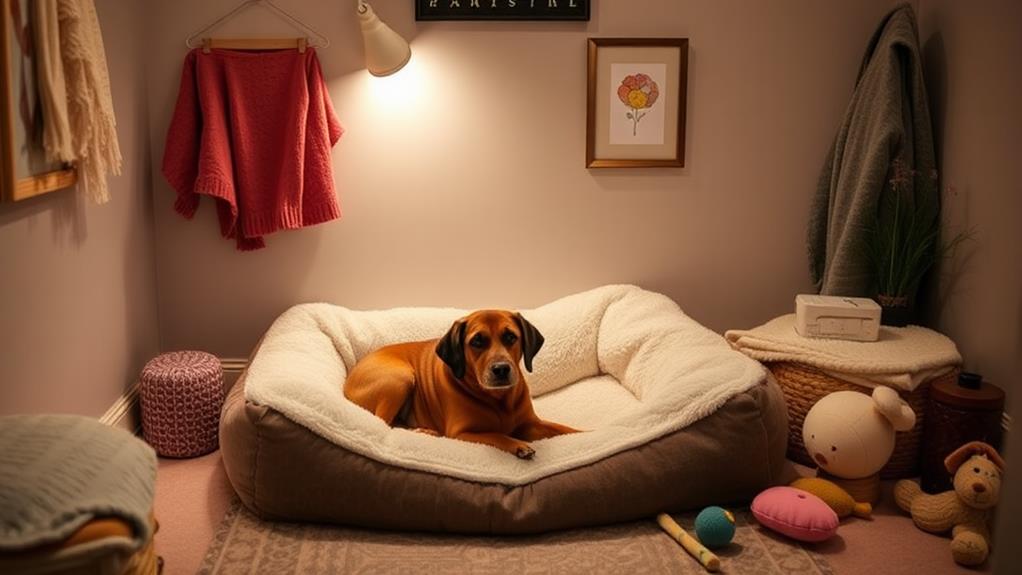
Creating a safe space for your dog is essential in helping them feel secure when you're away. Start by choosing a quiet area in your home where your dog can retreat. This space should be comfortable, with their bed, favorite toys, and a few familiar items to provide a sense of security.
Consider using a crate or playpen if your dog feels most secure in a confined area. Make it cozy by adding blankets or cushions. Guarantee this space is free from loud noises or distractions that might cause anxiety.
You can also incorporate calming elements, like a piece of your clothing or a soft blanket that carries your scent. This can help soothe your dog when they're feeling lonely.
Introduce this safe space gradually, allowing your dog to explore it at their own pace. Encourage them to spend time there with treats or toys, reinforcing positive associations.
Establishing a Routine
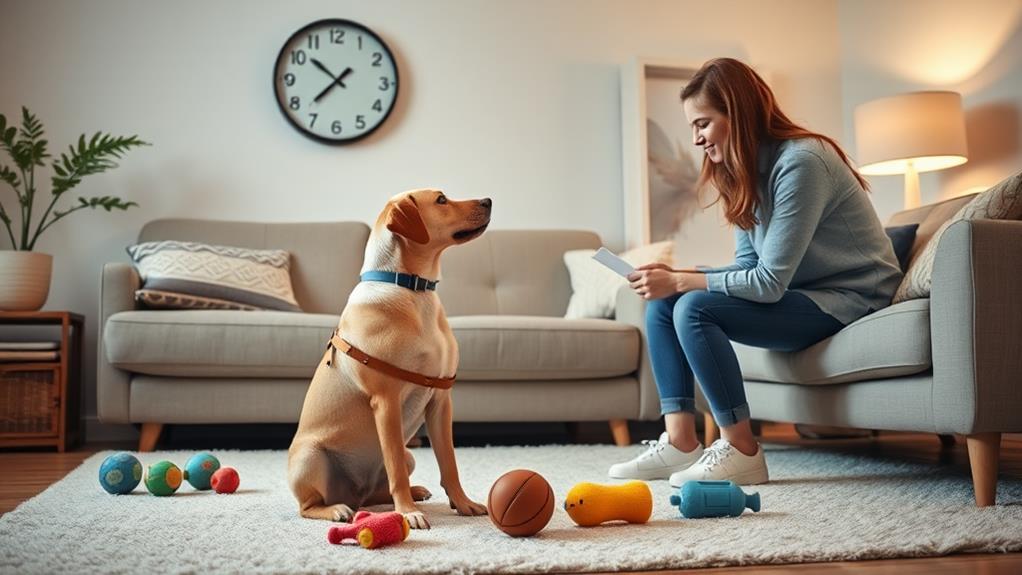
Establishing a routine can substantially reduce your dog's separation anxiety by providing them with a sense of predictability and security. When your dog knows what to expect, it can ease their stress during your absences.
Consistent Feeding Times: Serve meals at the same time each day. This helps your dog anticipate when they'll eat, creating a comforting structure.
Regular Exercise: Schedule daily walks or play sessions. Physical activity not only tires your dog out but also boosts their mood, making them more relaxed when it's time for you to leave.
Predictable Departure Rituals: Develop a short routine before you leave, like a specific goodbye phrase or a quick cuddle session. This can help signal that you'll return, making them feel more secure.
Interactive Toys and Distractions
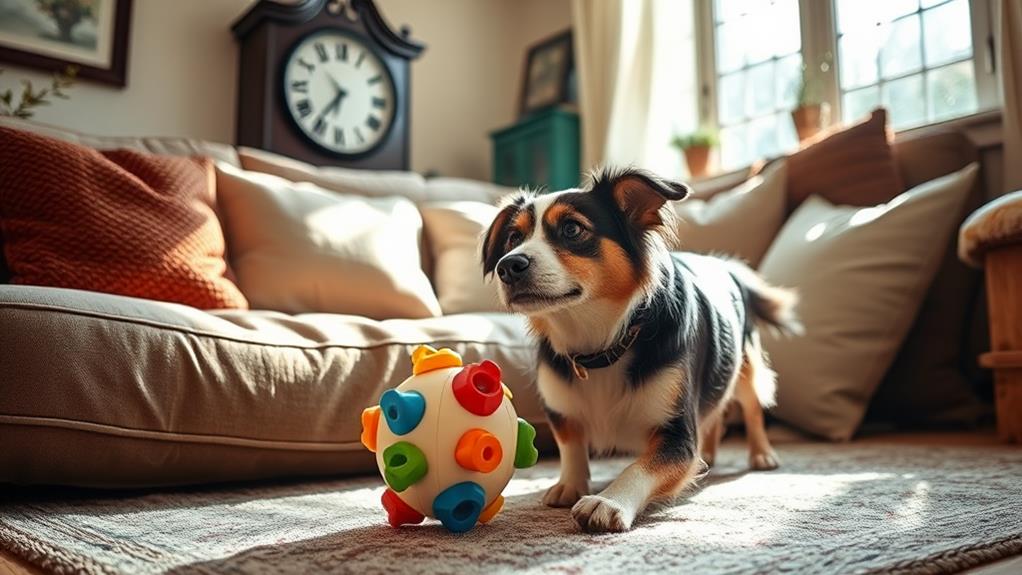
Interactive toys can be a game-changer for dogs struggling with separation anxiety. These toys not only keep your dog engaged but also help redirect their focus away from your absence. When you leave, filling their environment with stimulating toys can make a noticeable difference in how they cope.
Consider puzzle toys that require your dog to problem-solve to access treats. This activity can keep their mind occupied and provide a sense of accomplishment. Additionally, chew toys can help relieve stress, allowing your dog to engage in a natural behavior that promotes calmness.
Rotating the toys regularly can maintain your dog's interest, ensuring they stay mentally stimulated. You might also want to try interactive cameras that dispense treats. This not only entertains your dog but allows you to connect with them even while you're away.
Using these distractions can create a positive association with your absence, making it easier for your dog to stay calm. Remember, the key is to find toys that suit your dog's preferences and energy level. With the right interactive toys, you can help ease their anxiety and create a happier, more relaxed pup.
Professional Training Options
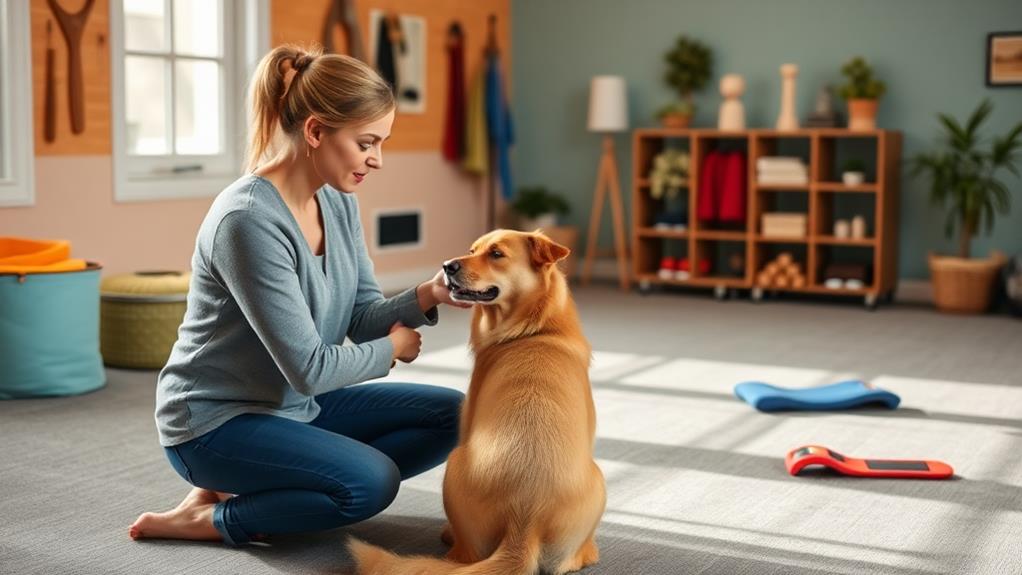
Seeking professional training options can be a critical step in helping your dog overcome separation anxiety. You may find that working with a skilled trainer can provide tailored strategies and support. Professional trainers often employ various techniques to address your dog's specific needs, ensuring a more effective approach.
Group Classes: These allow your dog to learn in a controlled environment with other dogs. You'll gain valuable insights from both the trainer and other pet owners.
Private Sessions: A one-on-one setting can be beneficial for focusing on your dog's unique challenges. The trainer can customize the training plan, making it more relevant to your situation.
Board and Train Programs: If your dog's anxiety is severe, you might opt for a board and train program. Your dog will stay with a trainer, receiving intensive training and socialization, which can lead to significant improvements in behavior.
Building a Stronger Bond
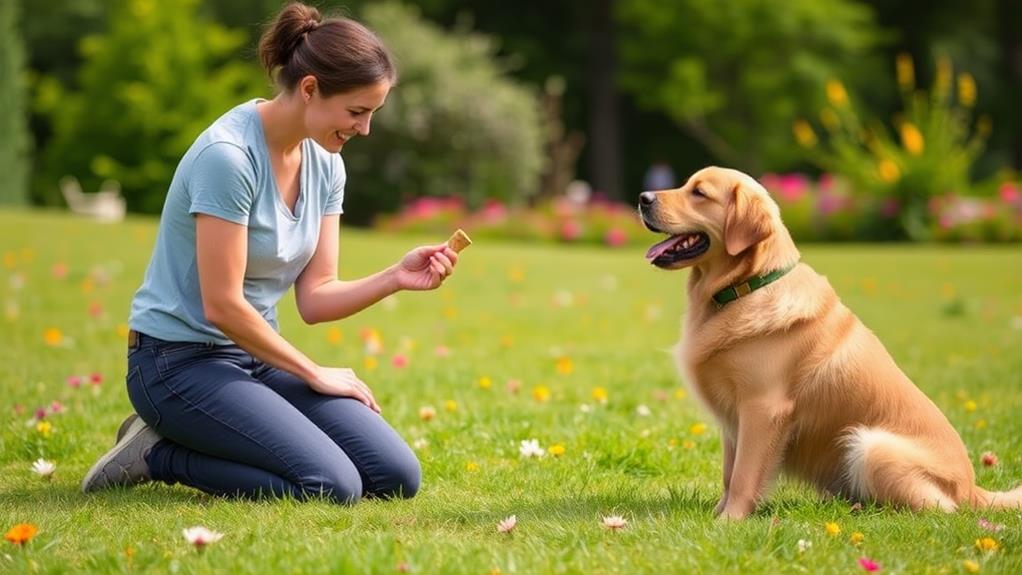
Building a stronger bond with your dog is essential for easing separation anxiety. When your dog feels secure and connected to you, it'll be easier for them to cope when you're not around. Start by spending quality time together. Engage in daily activities like walks, playtime, or training sessions. These interactions help reinforce trust and affection.
Positive reinforcement is key. Reward your dog with treats or praise for good behavior, especially when they handle short periods of separation. This encourages them to associate your absences with positive experiences, reducing anxiety.
Consider establishing a consistent routine. Dogs thrive on predictability, so regular meal times, walks, and play sessions can create a sense of security. When your dog knows what to expect, they'll feel more at ease.
Additionally, incorporate calming techniques such as gentle petting or soothing words before you leave. This can help your dog relax and understand that your departure isn't a cause for concern.
Ultimately, a strong bond built on trust and love will help your dog manage their separation anxiety, making both your lives more enjoyable and stress-free.
Frequently Asked Questions
Can Separation Anxiety Affect Specific Dog Breeds More Than Others?
Yes, separation anxiety can affect specific dog breeds more than others. Breeds like Labrador Retrievers and German Shepherds often exhibit higher tendencies. Understanding your dog's breed traits helps you address their unique emotional needs effectively.
How Long Does It Typically Take to See Improvement in My Dog?
Rome wasn't built in a day, and your dog's improvement won't happen overnight either. You might notice changes within a few weeks, but consistency and patience are key for lasting progress in their behavior.
Are There Any Medications to Help With Dog Separation Anxiety?
Yes, there are medications available to help manage your dog's separation anxiety. Consult your veterinarian to discuss options that suit your dog's specific needs, as they can recommend the best course of action for improvement.
Can Separation Anxiety Lead to Destructive Behavior in Dogs?
Yes, separation anxiety can definitely lead to destructive behavior in dogs. When they feel stressed or anxious, they might chew furniture, dig, or bark excessively. It's important to address these feelings early to prevent further issues.
What Should I Do if My Dog Regresses After Training?
If your dog regresses after training, stay calm and reassess your approach. Reinforce positive behaviors, increase consistency, and consider professional help. It's important to be patient; progress can take time and adjustments might be necessary.
Conclusion
In addressing separation anxiety, remember that over 14% of dogs experience this condition, making it a common issue among pet owners. By employing positive reinforcement, gradual desensitization, and interactive distractions, you can help your furry friend feel more secure. Establishing a consistent routine and considering professional training options can also strengthen your bond. With patience and understanding, you'll guide your dog toward a more relaxed state, allowing both of you to enjoy your time apart.

